Streaming Service Financial Model
This 5-Year, 3-Statement Streaming Service Financial Model is a comprehensive financial planning tool designed to help business owners, investors, and financial analysts evaluate the financial feasibility and profitability of your streaming service.
Financial Model For A Streaming Service
With these financial models, you can easily monitor revenues, track variable and fixed expenditures, or set up projections for future expansion, whether moving to a new office or updating a server. If you have any questions, contact us.
YOU GET? 2 Versions In 1 ZIP FILE. So you can decide which one is best for you.
Both are 5-Year 3 Statement.
Version 1: 5-Year, 3-Statement financial model, with 5 standard PAYG revenue streams
Version 2: 6-Tier Subscription. Sell your services under tiered 12-month agreements that increase in price as SLAs (Service Level Agreements) and monthly streaming hours or download sizes increase.
Plus 5 Inputs for PAYG Services.
Income Statement (Profit & Loss Statement)
Revenue Streams:
Subscription Revenue (Primary Income Source)
- Monthly subscription fees from all six tiers.
- Calculation:
(Total Users × ARPU) - Churned Users
Advertising Revenue (From Free-Tier Users)
- Ads served per free user per month × CPM (Cost per 1000 impressions)
- Example: 5 ads/user/day × $3 CPM × Free-tier users
Partnerships & Licensing Revenue
- Deals with content creators, bundling with telecom providers.
Merchandising & Pay-Per-View
- Special events, exclusive movie rentals.
Cost of Revenue (COGS)
Content Acquisition & Production
- Licensing Fees: Payments to studios.
- In-House Production: Content production costs.
Technology & Hosting Costs
- Cloud storage, streaming bandwidth.
Operating Expenses:
Marketing & Customer Acquisition
- Digital Ads, SEO, Influencer Partnerships.
Salaries & Operational Costs
- Engineers, customer support, executives.
General & Administrative (G&A)
- Office rent, software, legal.
EBITDA Calculation (Earnings Before Interest, Taxes, Depreciation, and Amortization)
EBITDA = Revenue - COGS - Operating Expenses
Net Profit Calculation
Net Income = EBITDA - Depreciation - Interest - Taxes
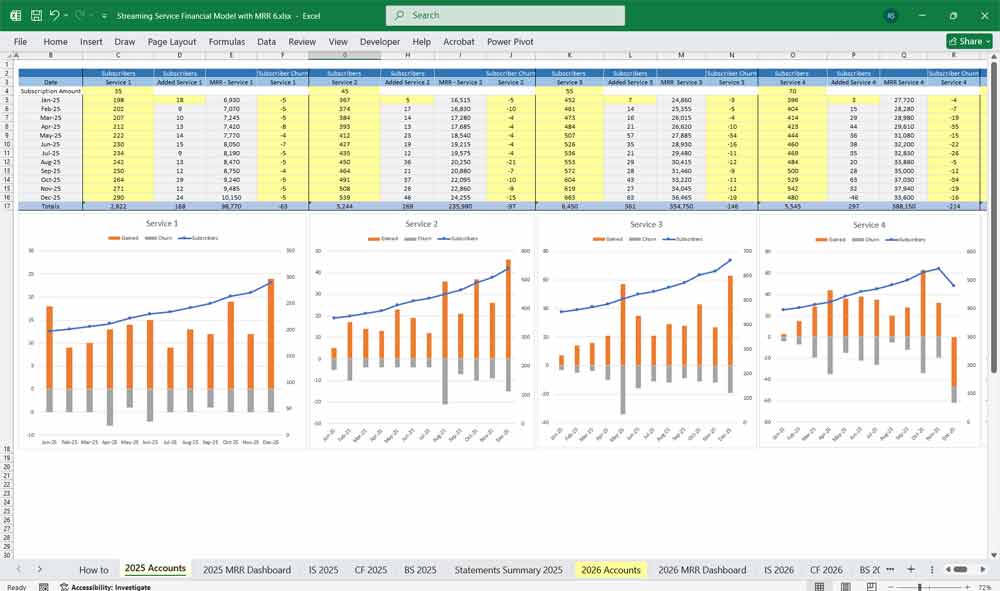

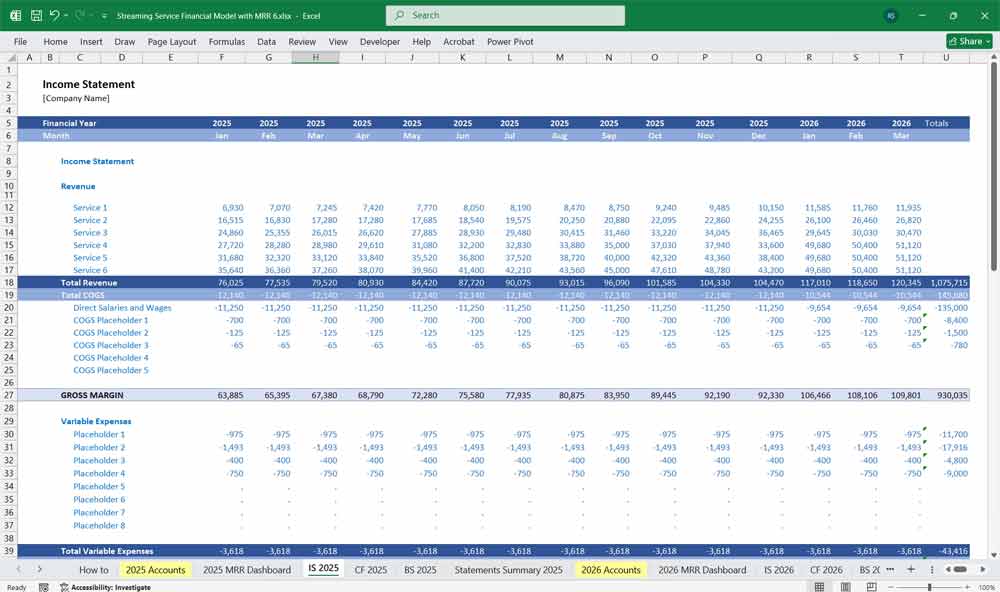
Streaming Service Financial Model Cash Flow Statement
Operating Activities:
- Cash Inflows: Subscription payments, ad revenue.
- Cash Outflows: Content acquisition, hosting, salaries.
Investing Activities:
- Capital Expenditures: Data centers, technology upgrades.
- Acquisitions: Buying content libraries.
Financing Activities:
- Equity Financing: Selling shares for funding.
- Debt Financing: Loans, bonds.
- Dividend Payouts: If applicable.
Net Cash Flow
Net Cash Flow = Cash from Operations + Investing + Financing
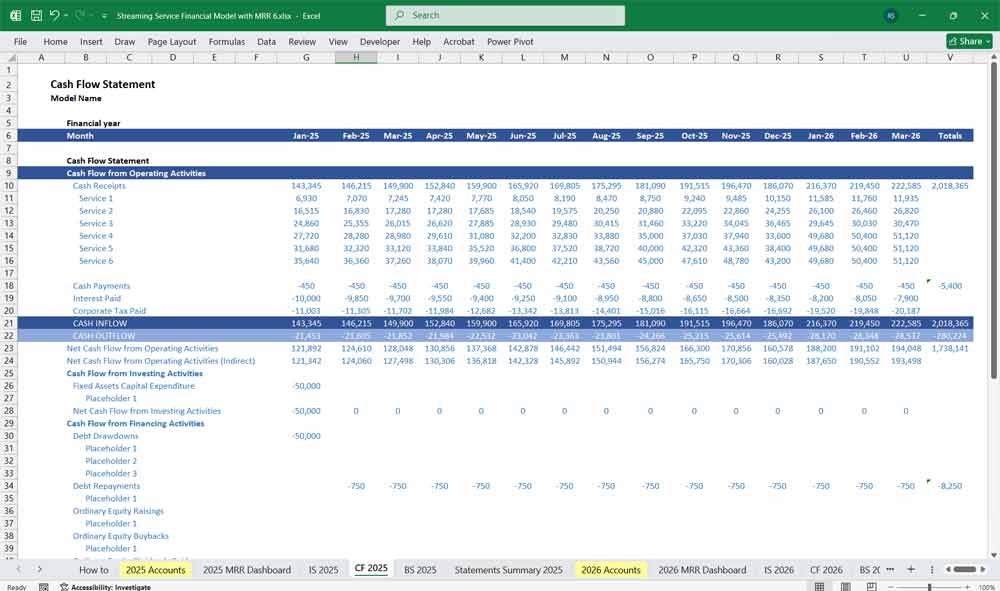
Streaming Service Financial Model Balance Sheet
Assets:
- Current Assets:
- Cash & Cash Equivalents
- Accounts Receivable (Subscription payments pending)
- Non-Current Assets:
- Intellectual Property (Owned content)
- Servers, IT Infrastructure
Liabilities:
Current Liabilities:
- Accounts Payable (Licensing fees due)
- Short-term Debt (Loans for expansion)
Long-Term Liabilities:
- Long-term Debt (Bonds, Loans)
- Deferred Revenue (Prepaid annual subscriptions)
Equity:
- Retained Earnings
- Shareholder Equity
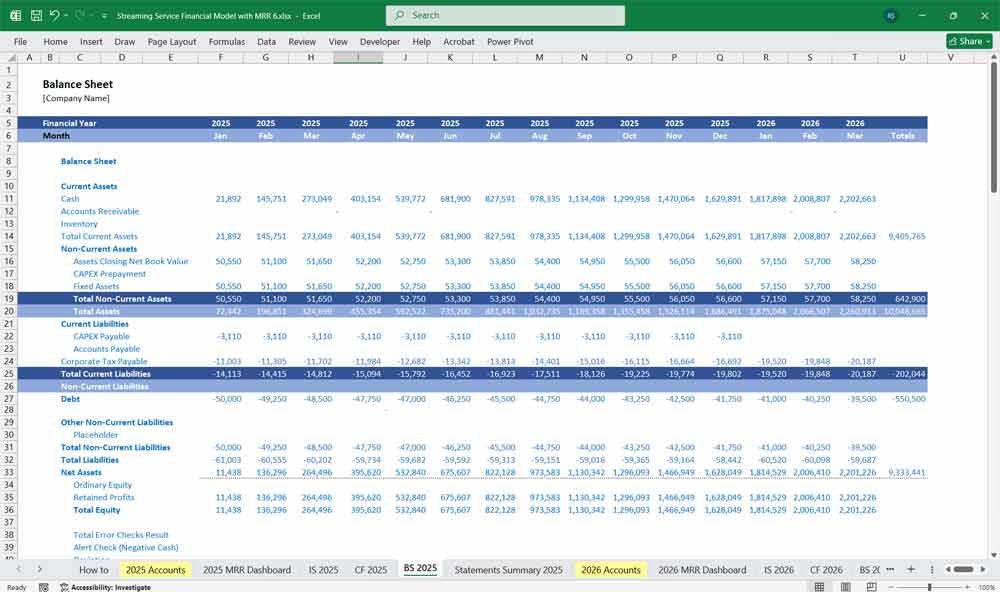
Key Metrics to Track
- ARPU (Average Revenue Per User)
- Churn Rate (Monthly Cancellations)
- Customer Lifetime Value (CLV)
- EBITDA Margin
- Cash Burn Rate
- Debt-to-Equity Ratio
When strategizing revenues for your streaming service, it’s important to organize them in a way that aligns with customer needs, market demand, and server operational efficiency.
Revenue Categorizations for a Streaming Company
1. Streaming Subscription Fees
- Monthly or annual recurring fees.
- Different tiers (basic, standard, premium) for varied pricing.
- Family and student plans with discounted rates.
2. Ad-Supported Streaming Model
- Ads shown during streaming content playback.
- Offers a free plan with limited features to attract users.
- Premium ad-free option for subscribers who prefer uninterrupted viewing.
3. Pay-Per-View (PPV) Streaming Model
- Charging for exclusive live events or streaming content.
- Higher charges for new releases or high-demand content.
- Special content access like exclusive sports events, concerts, or premieres.
4. Streaming In-App Purchases
- Purchase digital content like movies, shows, or music for offline viewing.
- Virtual goods or enhancements for the streaming platform.
- Ability to buy additional services (e.g., extra screen access, HD streaming).
5. Content Licensing and Streaming Distribution
- Licensing content to third-party platforms.
- Selling distribution rights for international markets.
- Allowing studios and independent creators to license their content.
6. Partnership Streaming with Internet Service Providers (ISPs)
- Bundling streaming services with ISP subscriptions.
- Joint marketing with ISPs to drive sign-ups.
- Special deals for customers who subscribe to both services.
7. Content Creation and Streaming Original Productions
- Producing exclusive original shows or films to attract subscriptions.
- Collaborations with famous creators, directors, or actors to increase appeal.
- Merchandising opportunities for original content franchises.
8. Affiliate Marketing with Other Streaming Brands
- Partnering with brands to offer affiliate links for related products.
- Promoting subscription services, merchandise, or tech gadgets.
- Offering exclusive deals or discounts for customers via affiliates.
9. Corporate and Bulk Streaming Subscriptions
- Offering discounted rates to businesses for employee access.
- Licensing the service for hotels, gyms, or lounges to provide entertainment.
- Custom plans for schools or educational institutions for student access.
10. Streaming Data Monetization
- Selling anonymized user data for market research.
- Targeted advertising based on user behavior and preferences.
- Selling insights to content creators or advertisers to optimize offerings.
11. Virtual Streaming Events and Experiences
- Charging access fees for live virtual events such as concerts or Q&A sessions.
- Offering VR or interactive live-streaming content with premium access.
- Exclusive VIP access to live events for a higher price.
12. Straming Company Content Merchandising
- Selling branded merchandise related to popular shows or movies.
- Partnering with online retail platforms and selling products.
- Licensing character or franchise designs for physical goods.
13. Sponsorship Streaming
- Partnering with major brands to sponsor exclusive shows or events.
- Co-branded content or products integrated into streaming platform offerings.
- Special advertisements and integrations during original programming.
14. Regional Pricing and Custom Streaming Packages
- Offering region-specific pricing to account for local economic conditions.
- Special packages targeting specific regions, with local content.
- Allowing users to pick and choose packages based on language and regional preferences.
15. Cloud DVR Streaming and Additional Storage
- Charging users for extra storage to save content.
- Offering cloud DVR service to record live programming.
- Higher-tier plans with additional cloud storage features.
16. Crowdfunding and Fan Contributions
- Raising funds for original content or series through fan contributions.
- Crowdsourcing projects with early access to content as a reward.
- Offering a platform for fans to fund and support creators.
17. Bundling with Other Streaming Services
- Bundling with other entertainment streaming services like music streaming.
- Offering packages with gaming and tech products (smart TVs, consoles).
- Partnering with news outlets, e-learning platforms, or sports streaming for bundled offers.
18. Licensing User-Generated Streaming Content
- Monetizing content created by users (e.g., videos, podcasts) on the platform.
- Sharing ad revenue with content creators based on engagement.
- Offering creators premium features because this increases upselling and monetization opportunities.
19. E-Commerce Streaming Integration
- Enabling in-app purchases of products related to shows (e.g., books, collectibles).
- Offering exclusive items for sale during content viewing (live shows or events).
- Cross-promotions for products in exchange for affiliate commissions.
20. International Streaming Expansion and Localization
- Expanding into new international markets with localized content.
- Offering unique local partnerships for content or revenue streams.
- Charging extra for access to international content libraries or features.
6 Tier Subscription Model for a Streaming Service
A subscription-based revenue model provides recurring income, increasing business stability. The tiers cater to different customer needs.
1. Free Streaming Tier (Ad-Supported)
Target Audience: Casual viewers, budget-conscious users, and new customers.
Features:
Access to a limited library of content (older shows, select movies, and curated playlists).
Standard video quality (up to 720p).
Ad-supported streaming with frequent ad breaks.
Benefits:
No cost to the user, making it accessible to a wide audience.
Opportunity to upsell users to higher tiers.
Ad revenue generated from high traffic.
Limitations:
No access to premium or exclusive content.
Ads may disrupt viewing experience.
Limited offline downloads or additional features.
2. Basic Streaming Tier
Target Audience: Individuals seeking affordable ad-free streaming.
Features:
Access to the full content library (excluding premium exclusives).
Ad-free streaming experience.
HD video quality (up to 1080p).
Limited offline downloads (e.g., 5 downloads per month).
Price: Low-cost monthly or annual subscription.
Benefits:
Affordable entry point for ad-free streaming.
Full access to most content.
Improved viewing experience compared to the free tier.
Limitations:
No access to 4K or HDR content.
Limited offline downloads.
No family or multi-device sharing.
3. Standard Streaming Tier
Target Audience: Individuals and small families looking for a balanced plan.
Features:
Full access to the content library, including some exclusive content.
Ad-free streaming.
HD and 4K video quality (where available).
Increased offline downloads (e.g., 10 downloads per month).
Two simultaneous streams allowed.
Price: Mid-range monthly or annual subscription.
Benefits:
Higher video quality and more downloads.
Suitable for small families or shared use.
Access to some exclusive content.
Limitations:
Limited to two simultaneous streams.
No access to ultra-premium features like HDR or Dolby Atmos.
4. Premium Streaming Tier
Target Audience: Families and power users who want the best streaming experience.
Features:
Full access to the entire content library, including all exclusives.
Ad-free streaming.
4K Ultra HD, HDR, and Dolby Atmos support (where available).
Unlimited offline downloads.
Up to four simultaneous streams.
Early access to new releases and special events.
Price: Higher monthly or annual subscription.
Benefits:
Best-in-class streaming quality and features.
Ideal for families or shared households.
Exclusive perks like early access to content.
Limitations:
Higher cost compared to lower tiers.
May include features not needed by all users.
5. Family Streaming Tier
Target Audience: Large families or groups seeking a shared plan.
Features:
Full access to the entire content library, including all exclusives.
Ad-free streaming.
4K Ultra HD, HDR, and Dolby Atmos support.
Unlimited offline downloads.
Up to six simultaneous streams.
Personalized profiles for each family member.
Parental controls and kid-friendly content filters.
Price: Premium monthly or annual subscription.
Benefits:
Designed for large families or groups.
Multiple profiles and parental controls for a tailored experience.
High-quality streaming and exclusive content.
Limitations:
Higher cost due to increased features and streams.
May be unnecessary for smaller households.
6. Ultra-Premium Streaming Tier (VIP or Elite)
Target Audience: High-income individuals or superfans who want the ultimate experience.
Features:
Full access to the entire content library, including all exclusives.
Ad-free streaming.
4K Ultra HD, HDR, Dolby Vision, and Dolby Atmos support.
Unlimited offline downloads.
Up to ten simultaneous streams.
Exclusive perks: behind-the-scenes content, meet-and-greet opportunities, or VIP event access.
Dedicated customer support (24/7 concierge service).
Personalized recommendations and curated playlists by experts.
Price: Highest monthly or annual subscription.
Benefits:
The most luxurious streaming experience available.
Exclusive perks and personalized service.
Ideal for superfans or high-income users.
Limitations:
Very high cost, making it niche.
Features may be excessive for average users.
Churn Analysis
Churn is one of the biggest revenue killers for streaming services. A 1% reduction in churn can significantly increase profits over time. Analyzing churn by subscription tier, revenue impact, and reasons for cancellation helps implement data-driven retention strategies to maximize long-term user value.
Strategies to Reduce Churn
Retention Strategies
✅ Content Personalization: AI-driven recommendations to increase engagement.
✅ Exclusive Content & Originals: High-quality content that isn’t available elsewhere.
✅ Loyalty Programs: Discounts for long-term subscribers.
Payment Recovery for Involuntary Churn
✅ Automated Payment Retries: Retries for failed transactions.
✅ Card Update Reminders: Notifications for expiring payment methods.
Engagement Tactics
✅ Win-Back Campaigns: Email campaigns offering discounts to churned users.
✅ Surveys & Exit Polls: Understand cancellation reasons and address pain points.
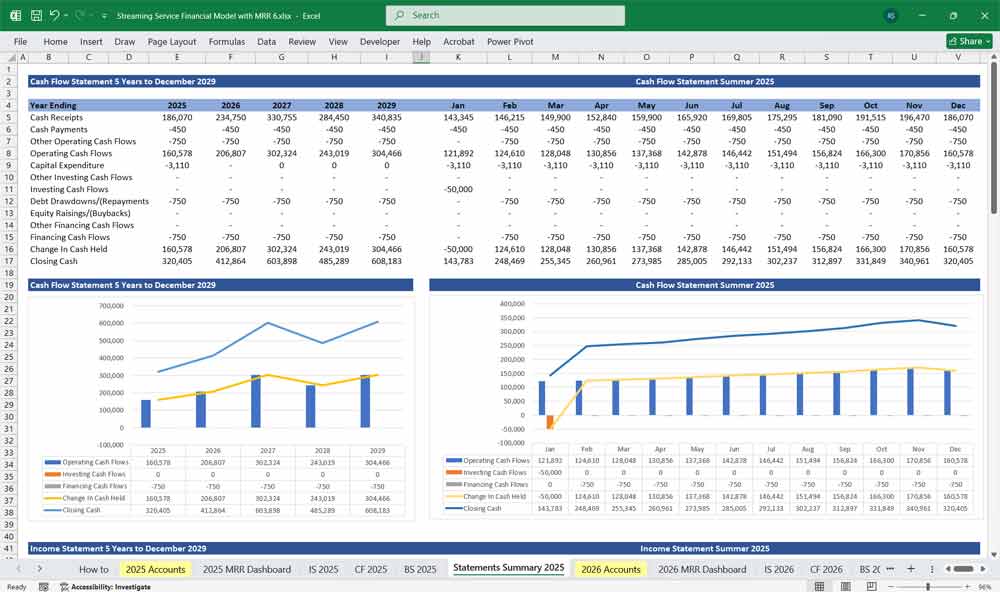
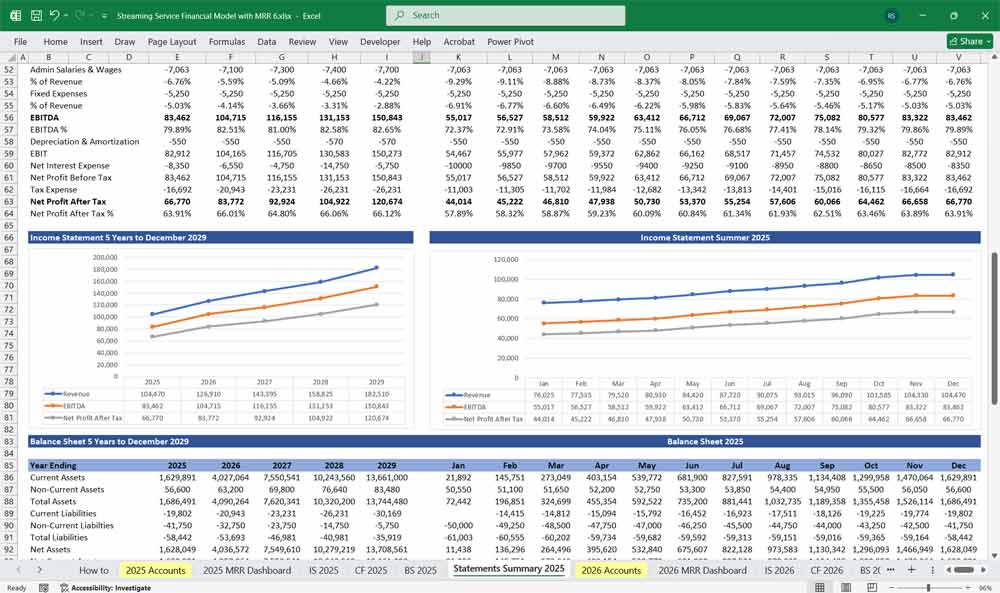
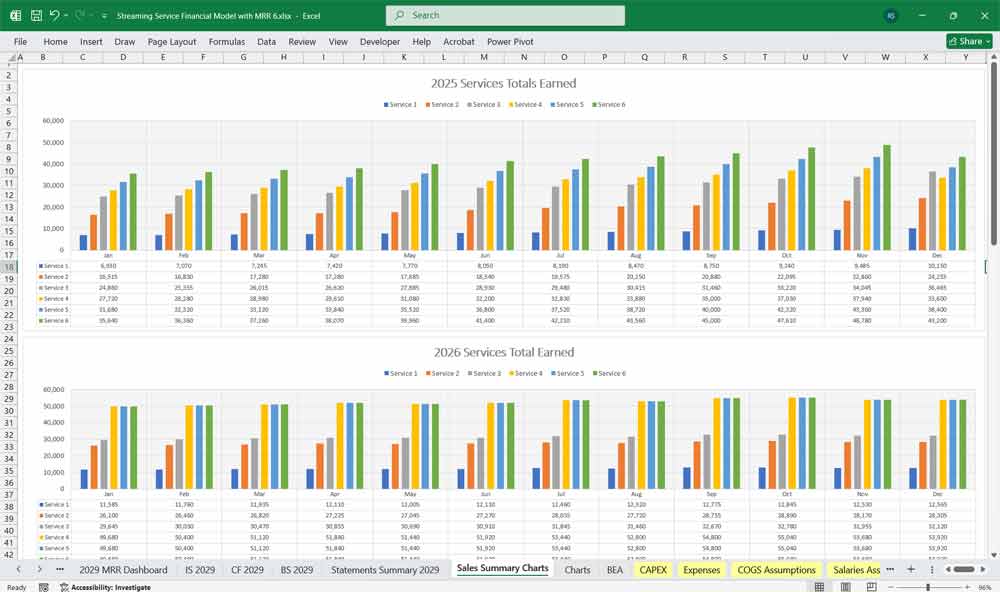
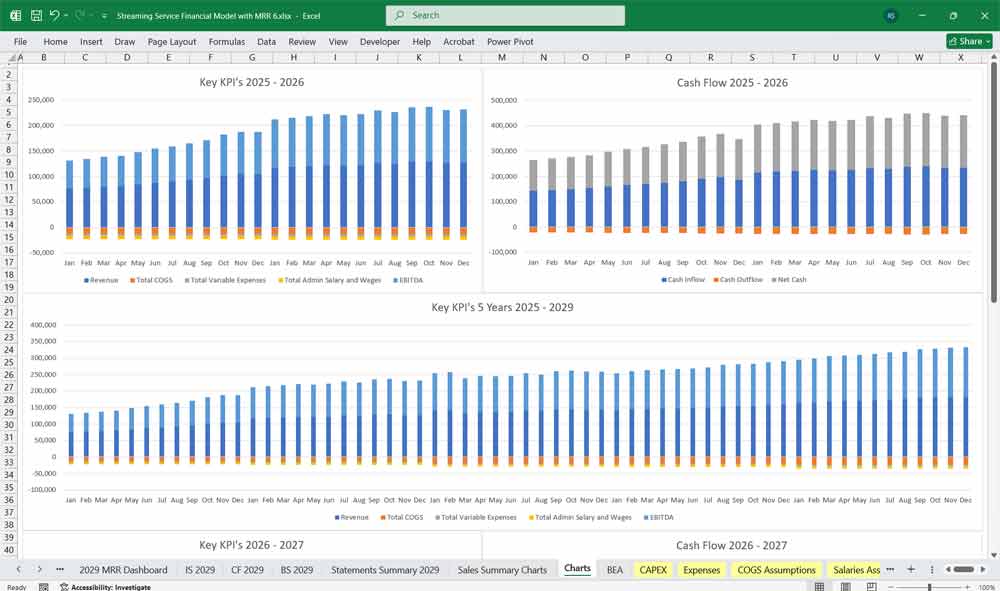
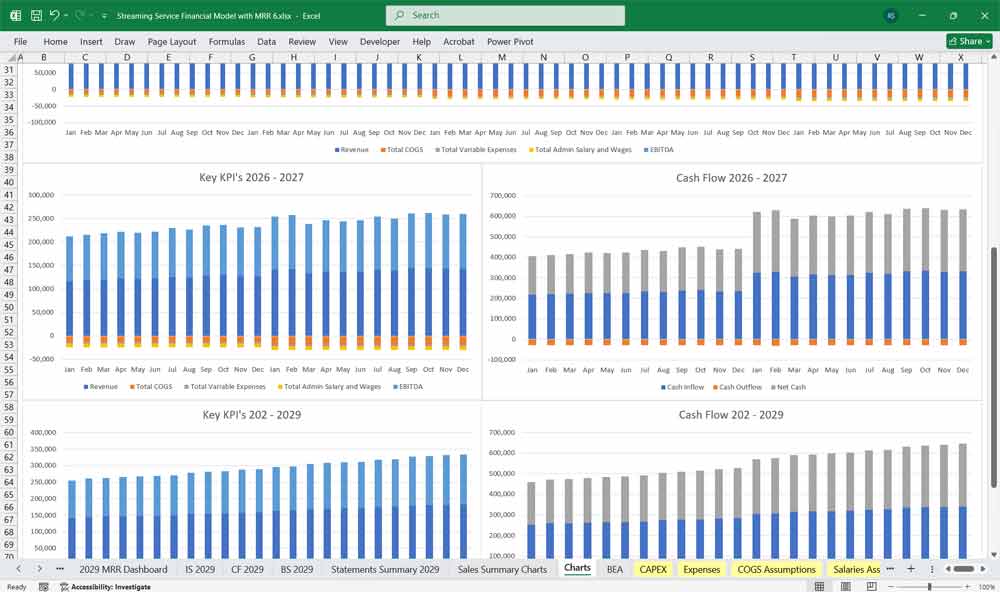
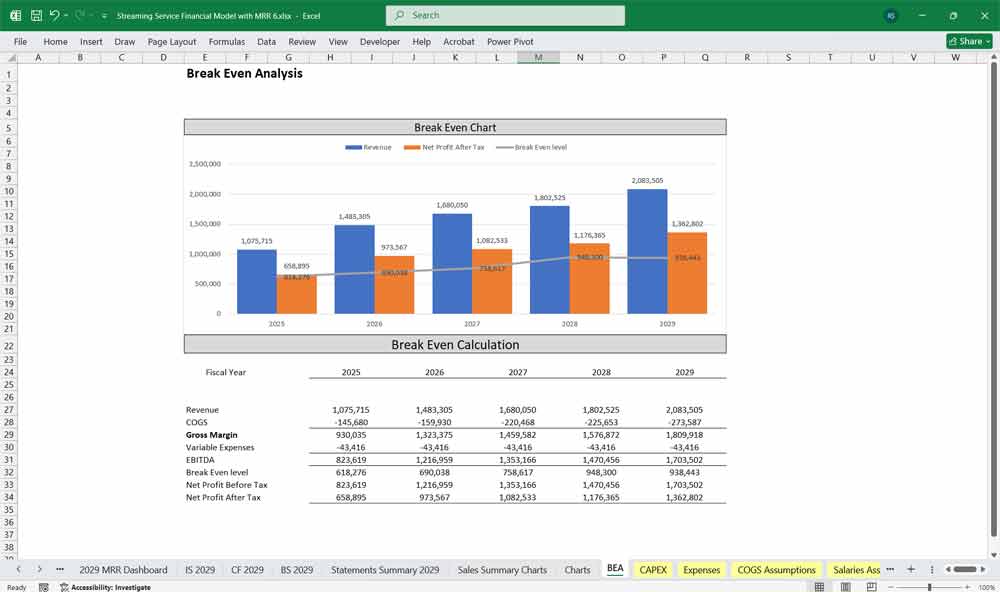
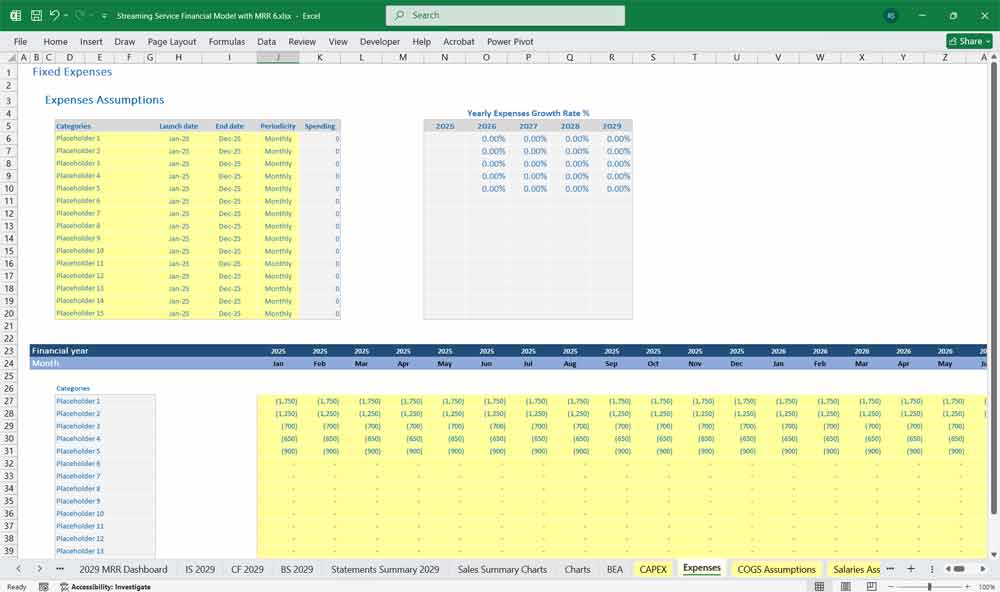
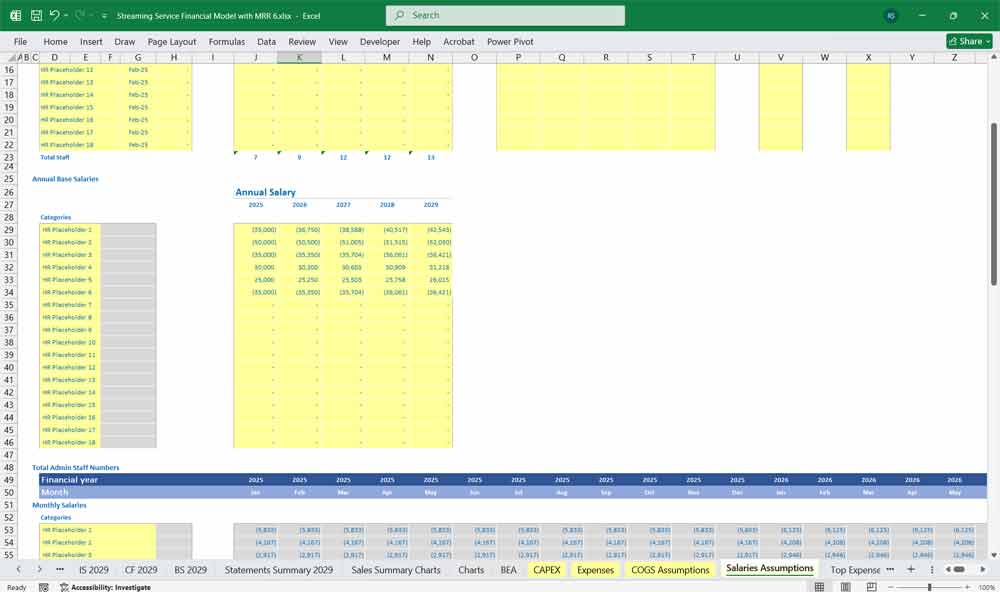
Conclusions For The Financial Model
These Streaming Service Finance Models in Excel are essential for planning, forecasting, and securing investment. With detailed income projections, cash flow tracking, and balance sheet monitoring, they ensure the business maintains profitability and financial health.
The 6-tier subscription model creates a reliable recurring revenue stream, increasing customer retention and long-term value.
Download Link On Next Page
